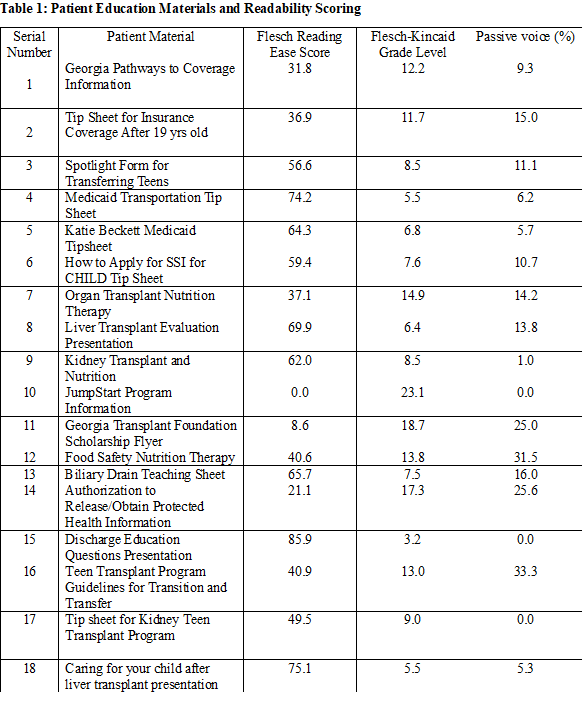Readability of patient and parent education materials in solid organ transplant clinic - A single center study
Shaan Thomas1, Jennifer Brasch3, Rene Romero2,3, Rouba Garro2,3.
1Atlanta International School, Atlanta, GA, United States; 2Emory University, Atlanta, GA, United States; 3Children's Healthcare of Atlanta, Atlanta, GA, United States
Introduction: The National Institutes of Health recommend that patient education material be written between a 4th- and 6th-grade level. In the U.S, 36% of adults have basic or below-basic health literacy. As such it is crucial that health-related materials created for patients should not exceed a 6th grade reading level, so as to remain accessible to a wide variety of patients and families. The aim of this study is to review the readability of patient materials used in a single pediatric transplant center to evaluate its accessibility for patients with low health literacy.
Methods: We evaluated 18 different patient education materials used by the pediatric transplant team. There is significant variation in types of material used- from power point presentations to instruction manuals and patient forms. The Flesch Reading Ease Score (FRES), Flesch-Kincaid Grade Level (FKGL), and the percentage of passive voice present in the text was calculated for all patient materials. The Flesch Reading Ease Score provides a 1-100 scale to measure the readability of a given text, with larger values indicating easier, higher readability. The Flesch-Kincaid Grade Level value shows the estimated reading level of a given text in the context of grade levels.
Results: The average Flesch Reading Ease Score (FRES) was 48.9, which corresponds to “difficult” in readability and the median FRES was 53.1, corresponding to "fairly difficult". The average Flesch-Kincaid Grade Level (FKGL) was 10.7, indicative of 10th grade reading level and the median FKGL was 8.8, indicative of late 8th grade reading level.

Conclusions: This data shows that patient materials are often at a level that exceeds the standards that need to be met for such materials to be accessible to a broad spectrum of patients. This may affect their understanding of the content and ability to follow management expectations. We are working on a quality improvement project to align all patient education materials to recommended readability standards.
[1] Patient Education
[2] Health Literacy
[3] Solid Organ Transplant